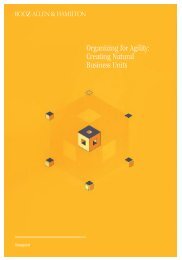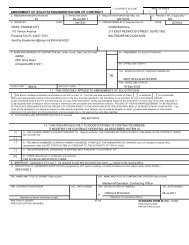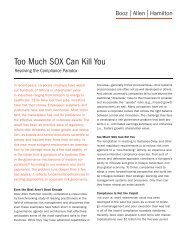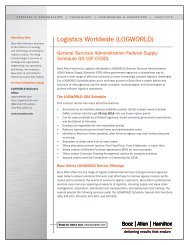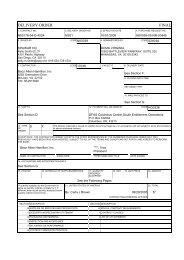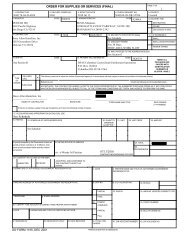Strategic Back Into Sourcing - Booz Allen Hamilton
Strategic Back Into Sourcing - Booz Allen Hamilton
Strategic Back Into Sourcing - Booz Allen Hamilton
You also want an ePaper? Increase the reach of your titles
YUMPU automatically turns print PDFs into web optimized ePapers that Google loves.
yMatt McKennamckenna_matthew@bah.comHarriet Engelengel_harriet@bah.comPutting the “<strong>Strategic</strong>” <strong>Back</strong><strong>Into</strong> <strong>Sourcing</strong>
1Putting the “<strong>Strategic</strong>” <strong>Back</strong> <strong>Into</strong> <strong>Sourcing</strong>The vice president of purchasing at a majorhigh-tech company emerged from another beatingat the monthly leadership team meeting.He had just proposed the centralization of thepurchasing department, including the idea ofbringing the company’s supplier quality and componentengineering groups under the purchasingumbrella. Not only did none of the other managerssupport this concept, but his boss rejectedthe idea outright without any hope of future discussions.The VP was sure that the only way tocontrol spending and increase savings in thiskey part of the supply chain is to centralize thedepartment. He was similarly rebuffed when heinitially proposed a supplier scorecard last year,cross-enterprise sourcing teams the year before,and the use of e-<strong>Sourcing</strong> tools the year beforethat. When those initiatives were eventually implemented,they reaped millions of dollars in costsavings for the company. Nevertheless, the VPcontinues to encounter roadblocks whenever hetries to introduce the latest sourcing conceptsinto the company. Why, he wonders, does it feellike he is trying to move a mountain every timehe proposes new ways to increase cost savingsthrough purchasing?As the case of this high-tech company illustrates,despite the fact that “strategic sourcing” programsbegan to proliferate in the 1990s, sourcing is stilllargely relegated to a nonstrategic position. Purchasingdepartments do not gain the respect that they deserve,although sourcing-related programs have producedhundreds of millions of dollars in cost savings formany companies. At issue is the manner in whichpurchasing departments usually seek these costsavings. Initiatives are generally piecemeal, tactical,and narrowly focused. Last year’s supplier scorecardis not linked to this year’s department reorganizationor previous strategic sourcing efforts or technologyimplementations. Management is continually askedto support these disorganized programs with preciousresources. Upon completion of these initiatives,budgets often get cut throughout the organization, andbusiness units, which bear the brunt of the budgetcuts, are asked to back yet another new purchasingplan that will monopolize additional resources in thefollowing years.When companies choose to back strategic purchasingprograms, savings are usually achieved, but these savingsare curtailed when enterprise support is limited.The primary reasons: Without full buy-in from the entirecompany, contracts aren’t adhered to, policies aren’tfollowed, and technologies aren’t fully utilized. A recent<strong>Booz</strong> <strong>Allen</strong> <strong>Hamilton</strong> survey found that when there iscross-functional participation in supply chain planning,purchasing savings increase by more than 20 percent.Despite the difficulties and company friction, we believethat now is the time to take the procurement agendato a higher level, by adopting a strategic, integrated
2approach to purchasing throughout the organization.To reach the full potential of the procurement agenda,organizations must take a broader, more holistic, andmore strategic approach to purchasing.A successful procurement agenda needs to addressfour key dimensions: processes, organization, technology,and performance management (see Exhibit 1).These dimensions must be developed into a comprehensiveplan and should be addressed one by one onthe basis of corporate and business unit objectives,goals, and strategies. The <strong>Booz</strong> <strong>Allen</strong> supply chainsurvey found that companies that are willing to takea broad approach and break the constraints of theirsupply chains achieve purchasing savings 55 percenthigher than those of companies just optimizing thechain within its current constraints.Evolution of ProcurementFor many years, the purchasing department servedlargely as clerical support for the business units.Its primary function was to send suppliers purchaseorders based on requisitions received from otherdepartments, which, in many cases, had alreadyselected the supplier and negotiated the price.Purchasing would also follow up on the orders andmake sure that the proper paperwork was completed.In addition, the purchasing department was occasionallyinvolved in administering contracts, and it kepttrack of supplier contact information.In the 1980s, many companies began to recognize theimportance of the purchasing function as they reducedtheir vertically integrated structures and began to lookExhibit 1<strong>Strategic</strong> Purchasing Agenda Source: <strong>Booz</strong> <strong>Allen</strong> <strong>Hamilton</strong>
3outside for suppliers. As a result, purchased goodsand services became a bigger part of the cost structureof many companies. The purchasing department,however, was typically not equipped to take a largerrole in managing these outlays, and the business unitswere hesitant to cede this control.With costs of purchased goods and services growing,in the 1990s there was a proliferation of “strategicsourcing” programs designed to cut back on expenditures.Companies organized cross-functional commodityteams to pursue more effective supplier strategies.The number of suppliers was reduced on many commoditiesso that companies could build stronger relationshipswith fewer, more critical suppliers. Moreover,new purchasing ideas began to attract attention. Forexample, <strong>Booz</strong> <strong>Allen</strong>’s “Balanced <strong>Sourcing</strong>” conceptdescribed a methodology for reducing costs and at thesame time building cooperative relationships with suppliers(see “Balanced <strong>Sourcing</strong>,” page 4). Long-termcorporate contracts were signed, especially for indirectitems (i.e. expenditures not directly related to production,such as travel and office supplies). Later in the1990’s, with the Y2K upgrades, technologies floodedthe market with promises of revolutionizing purchasingand the Internet age introduced new concepts likeWeb-based exchanges and auctions, e-<strong>Sourcing</strong>, andother online transactional programs.Many companies claimed huge savings as a resultof such initiatives. These nascent strategic sourcingefforts yielded cost cuts on indirect materials of anaverage of 10 to 15 percent. Furthermore, reverseauctioneers touted savings of up to 35 percent on avariety of custom and commodity products in manyindustries. But despite these gains, purchasing departmentshave continued, in many cases, to maintain anarm’s-length relationship with the business units, theirclients and the mechanism to realizing those savings.And too many companies have adopted the latest purchasingfad without connecting it to other initiatives.Consequently, these sourcing efforts often generateconfusion within the organization, especially with regardto how they fit into an overarching company strategyand how business units or the company will benefit.To overcome this chaotic approach to purchasing andto gain the greatest returns from procurement initiatives,companies should start by viewing procurementas a broad, cross-functional activity that extendswell beyond the purchasing department. They mustaddress the multidimensional nature of procurement,and develop and execute a coordinated multiyearinternal transformation program to adopt a successfulpurchasing strategy.The Home Depot Inc. has done this, and to goodeffect. The home improvement chain’s approach to purchasingdovetails perfectly with the company’s strategyof everyday low prices and regional variety. In 2001,Home Depot CEO Robert Nardelli consolidated itspurchasing of core products—75 percent of the itemsthe retailer sells—in a central purchasing unit at corporateheadquarters in Atlanta. The main reason for thismove, Mr. Nardelli said, was to gain better control overinventory (the number of products that Home Depotcarried had proliferated in the previous years) and touse bulk procurement leverage to purchase goods atthe lowest cost. And even while instituting this strategy,Mr. Nardelli continued to allow regional units tomake purchasing and inventory decisions regardingspecific products needed to satisfy their own markets.Today, the company backs this approach with proprietarytechnology used to forecast materials neededand to track both imported and domestic materials inreal time. Technology is also used to control maverickbuying, as only invoices from system- generated ordersare processed. In addition, systems provide exceptionreports that measure anomalies in the performance ofsuppliers. With this strategic approach to purchasingas a critical earnings driver, Home Depot’s operatingincome rose 14 percent between 2001 and 2003.Setting the AgendaTo achieve purchasing success similar to that ofHome Depot and other leading companies, thestrategic agenda must address the four elementsidentified earlier.
4Balanced <strong>Sourcing</strong>Tim Laseter wrote the book Balanced <strong>Sourcing</strong>: Cooperation and Competition in Supplier Relationships(Jossey-Bass) in 1998 while a Vice President at <strong>Booz</strong> <strong>Allen</strong> <strong>Hamilton</strong> to establish a framework andmethodology for developing cooperative relationships with suppliers and simultaneously achieving neededcost savings. Based on the firm’s experience and research, the book discusses the development of a broaderset of organizational purchasing capabilities:1. Modeling Total Cost 4. Integrating the Supply Web2. Creating <strong>Sourcing</strong> Strategies 5. Leveraging Supplier Innovation3. Building and Sustaining Relationships 6. Evolving a Global Supply BaseThe first three capabilities are the core processes for defining and developing the supply base; as such, theyare universally applicable to any type of company. The second three highlight different ways to leverage thesupply base for competitive advantage. Most companies focus on one of these latter capabilities at most;only the largest and most sophisticated companies can afford to pursue all three.1. Modeling Total CostUnderstanding the economics and the cost drivers of purchased goods and services through cost modelingis the most fundamental capability. It provides focus to cooperative efforts and ensures that prices reflectunderlying economics.2. Creating <strong>Sourcing</strong> StrategiesA sourcing strategy is analogous to a business strategy. Done well, both can create a competitive advantagethat will deliver superior returns. Just like a business plan, a well thought-out sourcing strategy reflects adeep understanding of industry economics and dynamics and, by quantifying the potential returns, presents acompelling case for investment.3. Building and Sustaining RelationshipsHow a company approaches the challenge of building and sustaining supplier relationships sets the tonefor long-term cooperation. Setting improvement targets, structuring incentives, and investing in supplierdevelopment all play a role in finding the right balance.4. Integrating the Supply WebAs companies’ relationships with suppliers grow ever more complex, the supply chain increasingly resemblesa web. Managing such a complex network becomes even more critical because the cost of an inefficientsupply web can be dramatic. Opportunities for improving the supply web have been a focal point for manyyears, but are far from tapped out.5. Leveraging Supplier InnovationCompanies employ a variety of techniques to manage technology development with suppliers. Settingaggressive but valid supplier cost targets, for example, drives cost improvement without ruining a cooperativerelationship. In recent years, many companies have shifted their attention from cost reduction to growth,enhancing their ability to innovate.6. Evolving a Global Supply BaseExpansion of the supply base outside a home market may be prompted by a desire to find low-cost suppliersor to support global expansion of the company’s operations. Whatever the motivation, the challenges ofpurchasing materials and parts from a distant location, currency exposure, and cross-cultural communicationmandate a substantial upgrade in capabilities for most organizations.These six capabilities still resonate today. However, in addition to the development of procurementprocesses and relationships with key suppliers, businesses also need to think about organizationalattributes, technology, and performance management. And the procurement agenda should include thedevelopment of a vision to achieve results that can be measured in the form of profitable operations andcompetitive advantage.
5Exhibit 2Best Practice Procurement Process Framework Source: <strong>Booz</strong> <strong>Allen</strong> <strong>Hamilton</strong>1. ProcessesProcurement process development needs to span thestrategic, tactical, and executional (see Exhibit 2).Well-defined processes should be driven by the overallcompany strategy and should bridge the extendedenterprise by connecting customers’ needs (via thebusiness units) to the supply base. <strong>Strategic</strong> processesshould be defined by the overall procurementpolicy. These processes establish which commoditieswill be needed and from whom they should be procured.Tactical processes address product and servicespecifications, as well as how much of each commoditywill be needed and when. In addition, companiesmust determine the types of supplier relationships thatthey require and design a plan to achieve those relationships.Executional processes set up the procureto-paysystem: how requisitions, purchase orders, andinvoices should be processed. All processes should beinterlinked to form the overall aligned process architecture.For example, a decision to employ a global sourcingstrategy should define supply base relationshipsand require executional processes that govern howpurchase orders must be processed.2. OrganizationPurchasing processes need to be supported by theappropriate organizational model. Organizational designcan frequently be a point of real contention within acompany. Business units want their “own” employeesmanaging their procurement to ensure that decisionsare made in their best interest, but corporate managementwants to ensure that initiatives benefit the organizationas a whole. Many companies view the organizationalmodel as a decision between centralized,
6Exhibit 3Purchasing Organizational Options Source: <strong>Booz</strong> <strong>Allen</strong> <strong>Hamilton</strong>decentralized, hybrid, and other structures (see Exhibit3). But a full organizational strategy needs to addressquestions of: Spend Segmentation: How should commodities be prioritizedto reflect the company’s strategic priorities? Roles and Responsibilities: What role should p urchasingplay for the various commodities (e.g.,managing the program, driving the agenda)? How andwhen should the business units be included in thesourcing process? Organizational Alignment: Will a centralized, decentralized,or hybrid structure best meet the organization’sneeds? Should any purchasing be outsourced? Whatpositions should be internal to purchasing and whichfunctions in other parts of the organization need tohave “dotted-line” reporting relationships to purchasing?Should purchasing employees be organized bycommodity or by business unit? Organizational Skill Matrix: What skills does the purchasingorganization need to have? What skills arecurrently in place? What is the training plan to rampup the necessary skills? Incentive Plans: What incentives does the organiza tionneed to have in place to ensure that the company ismotivated to support the purchasing strategy? Howcan employees be rewarded for their contributions?The overall organizational design not only needs tomirror the overall company organizational approach(e.g., a centralized purchasing organization would beout of sync in a decentralized model), but also needsto honestly assess the needs of the entire organization.A staged approach to redesign may be necessary.For instance, if the department does not currently possessthe skills needed to support a change from adecentralized to a centralized model, it may ultimatelymake more sense to build the skills first and changethe structure later.
7Exhibit 4Procurement Performance Management Framework Source: <strong>Booz</strong> <strong>Allen</strong> <strong>Hamilton</strong>3. TechnologyCompanies have multiple tools at their disposal toenable a successful purchasing strategy. Tools canhelp with strategic, tactical, and executional processes(EDI, electronic auctions, electronic RFPs, online catalogs,e-<strong>Sourcing</strong>, contract databases); performancemanagement (supplier scorecards, compliance management);and strategy development (expenditureanalysis, cost modeling). Individual tools might be rightor wrong for any given company. The key is for technologyinvestments to be made as integral components ofthe purchasing strategy—they cannot be “bolted on”as an afterthought. In addition, the company needs tohave a realistic view of how these systems fit into theoverall systems architecture, how much training will bemade available, and what the expected benefits will be,as well as a realistic view of the extent to which userswill actually employ the technology.4. Performance ManagementTo ensure that the processes and organization arefunctioning at the highest level, companies shoulddesign performance metrics that provide ownership,visibility, transparency, and accountability (see Exhibit4). Metrics need to be robust and explore the managementof both internal stakeholders and suppliers. Itis critical that information be timely so that the organizationcan react to problems quickly before they gotoo far. It is also important to understand the driversbehind performance so that appropriate correctiveaction can be taken. For example, a supplier who isfailing to meet stated lead times could be doing soeither because of its own poor performance or becauseit chronically receives last-minute orders from the company.These two scenarios would lead to vastly differentcorrective actions.
8Leaders recognize that creating a strategic sourcingprogram is a multiyear journey, and they think andplan accordingly. Each of the four elements describedabove must be addressed in an organization’s three- tofive-year plan. The order in which the elements shouldbe addressed will depend on recent initiatives andthe current state of the company. It is essential notto bite off more than an organization can chew at onetime. Companies should work to ensure that eachelement is linked to the others and the overall companyagenda with a common strategy. Furthermore, thestrategy should be self-funded. Credibility is quicklyestablished when executives apply a portion of savingsto future purchasing initiatives rather than requestadditional investments. In this way, the businessrecognizes the benefits, and purchasing is viewed asa core contributor to the company strategy and bottomline. For example, one of our clients, a major oil andgas company, paid for multiyear initiatives throughsignificant post-merger savings racked up by the purchasingdepartment.For those companies looking to implement comprehensivestrategic purchasing programs, a first step isto conduct a quick calibration of where the organizationstands relative to cross-industry best practicesin purchasing to assess the major gaps. Over time,companies can make an assessment of their progressiontoward best practice to determine if the strategyis working or if some element needs to be tweaked.Taking a strategic approach to purchasing will allow theorganization to fully recognize what sourcing practitionershave known for years: Purchasing can and shoulddrive sustainable results across the organization, andit therefore merits CEO-level attention.What <strong>Booz</strong> <strong>Allen</strong> Brings<strong>Booz</strong> <strong>Allen</strong> <strong>Hamilton</strong> has been at the forefront of managementconsulting for businesses and government for90 years. <strong>Booz</strong> <strong>Allen</strong> combines strategy with technologyand insight with action, working with clients to deliverresults today that endure tomorrow.With more than 16,000 employees on six continents,the fi rm generates annual sales of $2.7 billion. <strong>Booz</strong><strong>Allen</strong> provides services in strategy, organization, opera-tions, systems, and technology to the world’s leadingcorporations, government and other public agencies,emerging growth companies, and institutions.To learn more about the fi rm, visit the <strong>Booz</strong> <strong>Allen</strong>Web site at www.boozallen.com. To learn moreabout the best ideas in business, visit www.strategybusiness.com,the Web site for strategy+business, aquarterly journal sponsored by <strong>Booz</strong> <strong>Allen</strong>.
9Contact Information:BOSTONDermot ShortenVice President617-428-4426shorten_dermot@bah.comCHICAGODouglas HardmanVice President312-578-4558hardman_douglas@bah.comCLEVELANDCesare MainardiSenior Vice President216-696-1829mainardi_cesare@bah.comHarry HawkesVice President216-696-1574hawkes_harry@bah.comPatrick HoustonVice President216-696-1775houston_pat@bah.comMitchell QuintPrincipal216-696-1769quint_mitchell@bah.comDÜSSELDORFHOUSTONPeter HeckmannVice President49-211-3890122heckmann_peter@bah.comMatt McKennaVice President713-650-4156mckenna_matthew@bah.comHerve WilczynskiPrincipal713-650-4134wilczynski_herve@bah.comLONDONKeith OliverSenior Vice President44-20-7393-3227oliver_keith@bah.comHugh BakerPrincipal44-20-7393-3300baker_hugh@bah.comSimon HarperPrincipal44-20-7393-3434harper_simon@bah.comMichael A. WalshPrincipal44-20-7393-3421walsh_a_michael@bah.comNEW YORKSÃO PAULOSYDNEYMartha TurnerPrincipal212-551-6731turner_martha@bah.comHarriet EngelSenior Associate212-551-6734engel_harriet@bah.comLeticia CostaVice President55--11--5501-6205costa_leticia@bah.comTimothy JacksonVice President61-2--9321--1923jackson_timothy@bah.comDownloadable digital versions of this article and other <strong>Booz</strong> <strong>Allen</strong> <strong>Hamilton</strong> publications are available from www.boozallen.com.
Worldwide OfficesAbu DhabiCharles El-Hage971-2-6-270882BrisbaneTim Jackson61-7-3230-6400FrankfurtRainer Bernnat49-69-97167-0MadridMercedes Mostajo34-91-411-8450ParisBertrand Kleinmann33-1-44-34-3131ShanghaiEdward Tse86-21-6100-1696AmsterdamPeter Mensing31-20-504-1900Buenos AiresIvan De Souza54-1-14-131-0400GöteborgAnders Sewerin46-31-725-93-00McLeanMartin J. Bollinger703-902-3800PhiladelphiaMolly Finn267-330-7900StockholmJan-Olof Dahlén46-8-506-190-00AtlantaJoe Garner404-659-3600CaracasJosé Gregorio Baquero58-212-285-3522HelsinkiTimo Leino358-9-61-54-600MelbourneTim Jackson61-3-9221-1900Rio de JaneiroPaolo Pigorini55-21-2237-8400SydneyTim Jackson61-2-9321-1900BangkokTim Jackson66-2-653-2255ChicagoChris Disher312-346-1900Hong KongEdward Tse852-2251-8892Mexico CityAlonso Martinez52-55-9178-4200RomeFernando Napolitano39-06-69-20-73-1TampaJoe Garner813-281-4900BeijingEdward Tse8610-8520-0036ClevelandMark Moran216-696-1900HoustonMatt McKenna713-650-4100MiamiAlonso Martinez305-670-8050San DiegoFoster Rich619-725-6500TokyoSteve Wheeler81-3-3436-8631BeirutCharles El-Hage961-1-336433Colorado SpringsGlen Bruels719-597-8005JakartaTim Jackson6221-577-0077MilanEnrico Strada390-2-72-50-91San FranciscoBruce Pasternack415-391-1900ViennaHelmut Meier43-1-518-22-900BerlinRene Perillieux49-30-88705-0CopenhagenTorsten Moe45-33-18-70-00Lexington ParkNeil Gillespie301-862-3110MunichRichard Hauser49-89-54525-0SantiagoLeticia Costa562-445-5100WarsawReg Boudinot48-22-630-6301BogotáJaime Maldonado57-1-628-5050DallasTim Blansett214-746-6500LondonShumeet Banerji44-20-7393-3333New YorkDavid Knott212-697-1900São PauloLetícia Costa55-11-5501-6200WellingtonTim Jackson64-4-915-7777BostonJohn Harris617-428-4400DüsseldorfThomas Kuenstner49-211-38900Los AngelesTom Hansson310-297-2100OsloKarl Høie47-23-11-39-00SeoulJong Chang82-2-2170-7500ZurichJens Schädler41-1-20-64-05-020040077/12/04 PRINTED IN USA©2004 <strong>Booz</strong> <strong>Allen</strong> <strong>Hamilton</strong> Inc.




